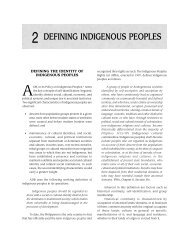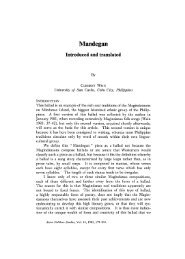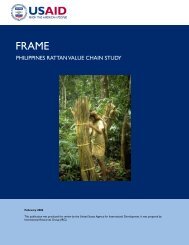PAPAYA - Aboutphilippines
PAPAYA - Aboutphilippines
PAPAYA - Aboutphilippines
Create successful ePaper yourself
Turn your PDF publications into a flip-book with our unique Google optimized e-Paper software.
<strong>PAPAYA</strong><br />
Papaya is a luscious fruit that has been taken for granted. The total crop area in the<br />
Philippines planted to papaya amounts to only 8,720 hectares or 0.1 percent of our<br />
agricultural land. Yet no one can deny its tastiness as a dessert or as an indispensable<br />
vegetables dish of various recipes. Papaya fruits are good sources of Vitamin A, B and C.<br />
It is a familiar meat tenderizer because for clearing fruit juices, on fermenting liquors, preshrinking<br />
the quality of wool and as soap for washing clothes. Papaya possesses<br />
medicinal values.<br />
Papaya can be easily grown in home yard gardens. It can also be a profitable enterprise.<br />
Under ordinary farm condition, production cost amounts to only P2,700 per hectare on the<br />
first year and P1,500 per hectare on the second year. The net profit on the first year may<br />
be less than P400 per hectare; but in the second year the returns can reach as high as<br />
P4,000 per hectare. The productive life of a papaya plant is about 3-1/2 years. This means<br />
that after establishing the plantation, income will flow with little effort provided you have a<br />
ready market.<br />
VARIETIES<br />
There are several cultivars you can choose from whether for backyard or commercial<br />
planting:<br />
1. “Cavite Special ” is a popular semi-dwarf type that blooms 6 to 8 months after<br />
planting. The fruit weighs from 3 to 5 kilos each and mainly eaten fresh.<br />
2. “Sunrise Solo” is a new improved high quality selection with reddish orange flesh,<br />
each fruit weighing half a kilo.<br />
3. “Waimanalo” is high quality variety with orange yellow flesh, each fruit weighing<br />
from one-half to one kilo.<br />
4. “Sinta” is the first Philippine-bred hybrid papaya, semi-dwarf, profile, sweet and<br />
flesh and weighs 1.2-2.0 kg./fruit.
LAND PREPARATION AND PLANTING<br />
Land preparation for papaya orchard is similar to other upland crops. First clear the fields;<br />
then plow and harrow alternately about 2 to 3 times to kill weeds and provide good internal<br />
drainage. The distance of planting papaya ranges from 2 to 3 meters depending on the<br />
variety.<br />
Papaya plants are usually planted by direct seedling in the field. Place 5 or more seeds in<br />
each hole; then cover with ¼ inch of soil. When fresh seeds are used, seeds will germinate<br />
in 10 to 14 days after planting. Seed germination is better and faster if the gelatinous<br />
envelope (sarcotestae) surrounding the seed is removed by means of the fingers. In some<br />
cases, seedlings are started in the nursery by sowing seeds in seed plots or individual<br />
containers such as in cans or plastic bags. Sow 3 to 4 seeds per container. Use sterilized<br />
soil to avoid nematode infestation and damping-off. Seedlings in the nursery should be<br />
grown under full sunlight to produce vigorous and hardy seedlings. Care should be taken<br />
not to disturb the root system. Constant watering is essential until plants are wellestablished.<br />
Seedlings are transplanted when there are 3 to 4 leaves.<br />
THINNING<br />
Thin papaya seedlings in the field 4 to 6 weeks after emergence. Leave only 3 of the<br />
strongest seedlings in each hole. Save plants that are spaced far enough from one<br />
another to allow minimum competition for sunlight and nutrients.<br />
The second and final thinning in the field should be done as soon as flowers appear. This<br />
is usually 4 to 6 months after seed germination. At this stage, leave one tree seedling per<br />
planting hole. In plantation where female trees are grown, some pollinating trees of either<br />
male or hermaphrodite forms should be preserved during the thinning process. Allow one<br />
male plant to grow for every 15 to 20 female trees for pollination purposes.<br />
CARE OF <strong>PAPAYA</strong> PLANTATION<br />
Establishment of Windbreaks<br />
Windbreaks are necessary in areas where strong winds prevail. Local materials used as<br />
windbreaks are ipil-ipil and madre de cacao. The distance between windbreaks varies with<br />
location. Where winds blow horizontally across the plantation, a common rule of thumb is<br />
to space windbreaks at a distance of 20-30 times the height of windbreak trees. Where<br />
winds come in different directions and angles, it is necessary to have windbreaks half as<br />
close.<br />
In general, a good windbreak should be permeable, allowing some air to pass through.<br />
Fertilization<br />
Factors such as soil types, rainfall, locations, cultural practices, and age of plant influence<br />
fertilization practices. Start fertilizing when seeds are planted or when seedlings are<br />
transplanted in the field. Mix a handful (5-10gms.) of complete fertilizer (14-14-14) with the
soil at the bottom of the hole before planting. As papaya seedlings grow larger, more<br />
fertilizer is applied.<br />
Guide for papaya fertilization in the Philippines:<br />
1. Apply 60 grams of ammonium sulfate as soon as plants are well-established and<br />
show new growth.<br />
2. Apply the same amount at intervals of six weeks until plants are one year old.<br />
3. Thereafter, apply 225 grams of ammonium sulfate per plant every three months.<br />
4. Apply 450 grams superphosphate per plant at the start of rainy season every year.<br />
5. In potassium-deficient soils, complete fertilizer with ratios 2:1:2 or 2:1:3 is<br />
recommended.<br />
Weed Control<br />
Weeds can be controlled by mechanical and chemical means. Hand-weed when papaya<br />
plants are less than 2- ½ meter high. Always keep one meter area around the trunk free<br />
from weeds.<br />
In large commercial papaya plantation, weed control is done by using herbicides. Spray<br />
pre-emergence herbicide to hinder weed control for six months without much damage to<br />
plants. Spray post-emergence herbicides such as Paraquat of Gramoxone plus a<br />
surfactant, at intervals between sprays 5-6 weeks. Since papaya seedlings are very<br />
sensitive to chemical sprays, remove weeds close to the seedlings manually.<br />
Inter-cropping<br />
Papaya can be grown as intercrop with coconuts, coffee, pineapple or assorted<br />
vegetables. Inter-cropping with papaya increases total farm income and reduces weeding<br />
expenses. It is important to provide fertilizer requirement of the intercrop.<br />
Harvesting<br />
Harvesting is a simple operation when papaya trees are short and the fruit can be reached<br />
by hands. The first harvesting starts on the 7th to 8th month after planting. Pick all fruits<br />
showing a tinge of yellow at apical end.<br />
Place harvested fruits in picking bags, galvanized containers or pails. Allow fruits to mature<br />
more fully to develop better flavor. However, this shortens shelf life and make them more<br />
susceptible to fruit fly infestation.<br />
When papaya trees grow older, harvesting is done with the use of ladder. It is a tedious,<br />
time-consuming and costly method of harvesting. Farmers in Cavite use a long pole to<br />
strike the apical end of the papaya fruit to detach it from the tree while the fruit is caught by<br />
hand.<br />
The papaya plant will keep on fruiting for many years but production declines rapidly as it<br />
grows older. Old trees grow slower and produce lesser fruits. The productive life span of
papaya plantations end after 3-1/2 years. The yield of well-managed papaya plantation is<br />
35 to 40 tons of fruits per hectare which is roughly 4 times the average yield (national) of<br />
10 tons per hectare per year.<br />
COMMON DISEASE AND PESTS OF <strong>PAPAYA</strong> AND THEIR CONTROL<br />
Diseases<br />
1. Phytophtora blight – caused by Phytophtora palmivora. Common symptoms are found<br />
on stems and fruits. Small, water-soaked, discolored spots may occur anywhere on the<br />
stem, around the fruit or leaf scars, especially during fruit production. These infected areas<br />
enlarge and often completely encircle stems of young trees. Green fruits are resistant to<br />
infection but can be invaded through the wound or through the peduncle from the stem<br />
cankers. Infected mature fruits that hand on the tree shrivel as disease progresses, turn<br />
dark brown, become mummified and fall to the ground. Mummified fruits become reservoir<br />
for fungus and source of infection.<br />
Control – remove rotting fruits from the tree as these serve as reservoir of spores from<br />
fungal mass which is carried by rain or wind to healthy parts of plants. These spores may<br />
infect non-injured leaf tissue, stems or fruit. Good drainage conditions reduce infection and<br />
use of protectant spray such as copper sulfate or Dithane M-45 fungicides limit extent of<br />
injury.<br />
2. Anthracnose – Affects both plants in the field and the fruits at harvested. First symptom<br />
is usually a small, round, water-soaked area on ripening portion of the fruit. As fruit ripens,<br />
these spots enlarge rapidly, forming circular, slightly sunken lesions; these enlarge up to 2<br />
inches in diameter as fruit matures. Fungus frequently produces large, light orange or pink<br />
masses of spores in the center of the lesions. Sometimes spores are produced in<br />
concentric rings similar to a bull’s eye. In addition to producing this surface damage, the<br />
fungus also advances into the fruit.<br />
Occasionally, green portions of the papaya become affected with anthracnose. Disease<br />
first appears as a small, water-soaked lesion. Soon after fungus penetrates the fruit, latex<br />
comes out in sticky mound of horns. These lesions enlarge to ½ inch in diameter as fruit<br />
remains green and eventually plant dies. Infected petioles may act as source of inoculum<br />
for infection of fruit.<br />
Control – Control of this disease can be achieved only by means of a thorough spray<br />
program. In rainy areas with high temperatures, spray Dithane M-45 at 7 to 10 days<br />
intervals. Copper-based fungicides also provide good control.<br />
3. Papaya mosaic – Initially, leaves develop rugged appearance. Undersides of leaves<br />
show thin, irregular, dark-green lines etching the borders of cleared area along veins.<br />
Younger leaves of crown are generally stunted and severely chlorotic with veins banding;<br />
transparent oily areas are scattered over leaf or along leaf veins. In mature leaves,<br />
chlorotic patters is light color between veins accompanied by numerous small rinds<br />
ranging from transparent yellow to tan yellow. In several affected areas, defoliation
progresses upward until only a small tuft of leaves remains at the crown. Stems of infected<br />
plants show pinpoint-sized, water-soaked spots may develop into linear or concentric ring<br />
patterns, w/c become larger and more intense in color. This is generally transmitted by<br />
green peach aphid, Myzuz persicae.<br />
Control – The only satisfactory way of controlling mosaic is by destroying source of the<br />
virus. A strick roguing program should also be followed:<br />
• Spray all infected trees with insecticide to kill aphid carriers.<br />
• Cut all infected trees and remove them from growing trees and other cucurbit<br />
plants.<br />
• Avoid nearby cultivars of cucurbit plants.<br />
• Control aphids with pesticides since they are disease-carriers.<br />
Insect Pests:<br />
1. Mites – They colonized on different parts of plants and feed on plant, causing premature<br />
leaf drop, reduce tree vigor and produce external blemishes on fruit. They puncture plant<br />
tissues with their needle-like mouthparts and feed on tissue juices. Some mutiply rapidly<br />
throughout the year and cause widespread damage in a very short time.<br />
Control – Control mites by sulfur dustings. Spray Malathion at rates recommended by<br />
manufacturers.<br />
2. Fruit fly – These infest papaya when fruits are allowed to ripen on the tree beyond<br />
recommended picking stage. Fruits harvested in the mature green stage are not infested<br />
due to the milky substance they exude when fruit is punctured.<br />
Control – Sanitation is important. Destroy all dropped and pre-mature ripe fruits and<br />
suspected of being infested to prevent larvae from developing into adults flies.<br />
MEDICINAL VALUES OF <strong>PAPAYA</strong><br />
Bruised papaya leaves are used as poultice in treating rheumatism. In nervous pains,<br />
leaves can be dipped in hot water or warmed over a fire and applied. As purgative, one<br />
tablespoon of the fresh fruit juice mixed with honey and 3 to 4 tbsp. of boiling water is<br />
taken one draught by an adult; two hours later, it is followed by a dose of castor oil. This<br />
treatment is repeated for 2 days, if necessary, for children aged 7 to 10 years old. The<br />
children under 3 years, half the dose is given.<br />
source: www.da.gov.ph<br />
Read Related Posts:<br />
• How to Make Papaya Jam (Food Business)<br />
• How to Make Atsara (Achara)<br />
• Red Lady Papaya Nursery Business<br />
• Invest in Sinta Papaya Production
• Simple Procedures in Making Fruit Jams<br />
Ref.: http://www.mixph.com/2006/12/growing-papaya.html

















